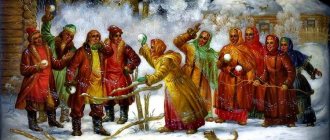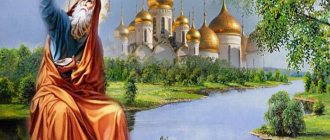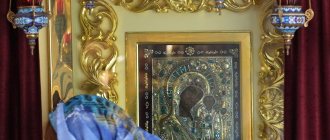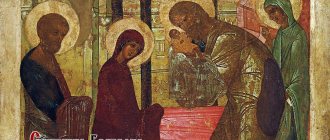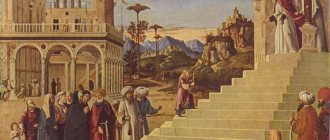In Orthodoxy, the especially revered twelve holidays are divided into the Lord's and the Theotokos. In the second half of September, believers celebrate a great celebration associated with the birth of the Mother of God. This is the feast of the Mother of God, celebrated magnificently in churches with solemn services and obligatory chants.
It is important for those who observe traditions and rituals to know what day the holiday falls on. This will allow you to plan things, remember to congratulate loved ones, and observe weather phenomena and signs.
What is the twelfth holiday?
This name arose from the Slavic “twelve” - that is, “twelve”. In the church classification, these holidays are the most significant after Easter, and they are celebrated with special celebration. All twelve holidays are dedicated to the events of the earthly life of Jesus Christ and the Blessed Virgin Mary. In the Typicon (the statutory document of the Church regulating the rules and procedure for performing divine services) they are marked with a red cross in a full circle, which also emphasizes their significance.
There are dates relating to the twelve holidays, such as pre-celebrations, post-celebrations and giving . In the first case, believers prepare for a great event and begin to celebrate in advance. In secular tradition, by the way, there is an unspoken sign that it is impossible to celebrate the holiday in advance, as well as to congratulate it. In Orthodoxy, the forefeast day prepares a person for celebration, reminds him of events, and helps him tune himself into a spiritual wave that he may have lost due to being busy with everyday affairs.
After-feast is a continuation of the holiday, which usually occurs after a few days. And giving , as you guessed, is a “farewell” to the holiday until its next occurrence. The spread of celebrations over time, even if a person cannot always attend the service, thanks to the presence of a calendar, helps one to remember and, together with the entire Church, live through the events of the holiday, think about one’s soul, the meaning of life, and mentally compare oneself with the “heroes” of memorable dates. This allows the believer to engage in spiritual self-development, because comparison with a saint will certainly show his own imperfection.
Signs of the holiday
It is no coincidence that according to popular belief, the celebration was called the Little Most Pure One. By this day, they tried to remove vegetables and grains from the beds and fields, prepare (clean) arable lands and vegetable gardens for winter. We finished harvesting onions (“onion week”) and worked in the apiary, preparing the bee hives for a long winter.
Be sure to take note of the weather:
- there are many stars in the sky on the eve of the celebration - expect imminent cold weather;
- heavy fog in the morning on the Nativity of the Mother of God - for rainy autumn;
- the morning is clear and cool - there will be no rain in the near future;
- birds fly low - for a frosty winter;
- It is raining heavily on the holiday - wait for rain for another forty days;
- when it was raining, a rainbow appeared in the sky - autumn will be warm and clear.
They prayed to the Mother of God, asking for conception, for the health and well-being of children and relatives, for speedy healing from illnesses. Be sure to glorify the Mother of Christ, offer prayers for the granting of strength to overcome the difficult path, for protection, for mercy. They thanked him for his help, for his recovery, and asked him not to leave me in difficult times. It was customary to pray not only in church, but also at home, in front of images, especially for those who, due to various circumstances, cannot attend services in church.
What Orthodox holidays belong to the twelfths?
Here they are, many of them are probably familiar to you:
- Nativity of the Blessed Virgin Mary
- Exaltation of the Holy Cross
- Presentation of the Blessed Virgin Mary into the Temple
- Nativity
- Epiphany
- Presentation of the Lord
- Annunciation of the Blessed Virgin Mary
- Entry of the Lord into Jerusalem
- Ascension of the Lord
- Day of the Holy Trinity
- Transfiguration
- Dormition of the Blessed Virgin Mary.
Why is Easter not one of the twelve holidays?
But you are probably wondering: why is everyone’s favorite Easter, the day of the Bright Resurrection of Christ, not among these holidays? The greatness and significance of the events of Easter for Orthodox Christians is so great that this date, the day on which the Crucified Jesus Christ rose from the dead, rose from the grave after a painful death, is usually placed above the twelve holidays. The Resurrection of Christ, as it were, crowns these important memorable dates. By the way, on the icon of the twelve holidays, the fragment dedicated to Easter is traditionally depicted in the middle, while the events of the twelve holidays are placed around the perimeter of the icon.
Icon depicting the twelve feasts
Moving and non-moving holidays
The basis for the worship of the Orthodox Church is the annual calendar. It is he who determines the dates of celebrations and the order of service. The twelfth holidays are movable (that is, their date always changes depending on the indications of the calendar) and immovable (that is, they have a strictly fixed date).
Moving holidays include:
- Entry of the Lord into Jerusalem (Palm Sunday). It is celebrated a week before Easter, and is always celebrated on different dates, since Easter is also a moving date on the calendar.
- The Church remembers the Ascension of the Lord on the 40th day after the feast of the Holy Resurrection of Christ, and, as we see, it also completely depends on this date.
- Trinity Day falls on the 50th day after Easter.
Permanent holidays make up the majority among the twelve (dates in brackets according to the new, modern style):
- Nativity of the Blessed Virgin Mary - September 8 (21);
- Exaltation of the Holy Cross - September 14 (27);
- Presentation of the Blessed Virgin Mary into the temple - November 21 (December 4);
- Christmas - December 25 (January 7);
- Epiphany of the Lord - January 6 (19)
- Presentation of the Lord - February 2 (15);
- Annunciation of the Blessed Virgin Mary - March 25 (April 7);
- Transfiguration of the Lord - August 6 (19);
- Dormition of the Blessed Virgin Mary - August 15 (28).
When and what date is the Nativity of the Blessed Virgin Mary in 2021
The big holiday belongs to the twelfth year and is one of the most revered celebrations in Orthodoxy. The list of twelve memorable dates contains both non-movable (with a fixed date) and movable holidays. The Nativity of the Mother of God is an event with a fixed date, falling on September 21 according to the new style.
According to the rules of the old chronology, the Birth of the Virgin Mary is celebrated on September 8, but since we use the Gregorian calendar, the Orthodox celebrate the celebration on September 21.
For many churches in Russia, the Nativity of the Virgin Mary is a patronal holiday. This means that the building was consecrated in honor of this event, so parishioners traditionally celebrate the celebration on a large scale, with a procession of the cross, sprinkling houses, outbuildings, fields, and meadows with holy water. Among the churches with the patronal feast of the Nativity of the Mother of God are churches in Kargopol, Tyumen, Samara, Kerch, Kaliningrad. The monastic monasteries celebrate the celebration: the Nativity of the Virgin Mary in Bogolyubovo (Vladimir region), Tula, Rostov (Yaroslavl region), deserts in Baryatino (Kaluga region), Lukyantsevo (Vladimir region).
Lord's and Mother of God holidays
Another classification of the twelve holidays concerns their content. It has already been said above that the holidays are dedicated to the events of the earthly life of Jesus Christ and the Blessed Virgin Mary. Therefore, another division of them was called the Lord's and the Theotokos.
Lord's holidays:
- Exaltation of the Holy Cross;
- Nativity;
- Epiphany;
- Transfiguration;
- Entry of the Lord into Jerusalem;
- Ascension of the Lord;
- Day of the Holy Trinity.
Mother of God holidays:
- Nativity of the Blessed Virgin Mary;
- Presentation of the Blessed Virgin Mary into the temple;
- Annunciation of the Blessed Virgin Mary;
- Dormition of the Blessed Virgin Mary;
- Meeting of the Lord.
How are the twelve holidays different, besides who are they dedicated to? Features of the service when it falls on a particular date, day of the week, or a coincidence in date with each other. The Lord's holidays, as well as Sunday - Little Easter - will always take priority over the Feast of the Theotokos in the rite of worship.
The meaning and significance of the twelve holidays
Speaking about the twelve holidays, their name, dedication and classification, we must not forget about their meaning. This is how it will become clear why these 12 events have special veneration among Orthodox Christians.
Nativity of the Blessed Virgin Mary
The Most Holy Theotokos was assigned an important mission to save fallen humanity from the slavery of sin. It was through the immaculate Virgin, born of righteous parents, Joachim and Anna, that Jesus Christ was to come into the world. And so it happened. Old Testament prophecies warned about the birth of the Mother of God and Her appearance was predetermined. She became the Gate through which God came to people, becoming outwardly similar to them.
Icon of the Nativity of the Blessed Virgin Mary
Exaltation of the Holy Cross
In 326 in Palestine, during excavations by the Empress Catherine of Constantinople and the Bishop of Jerusalem Macarius, three crosses were discovered, the same ones on which Jesus Christ and two thieves were crucified. According to legend, when one of the crosses was placed on a sick woman, she received healing. This is how a significant Christian shrine was defined. The cross in the ancient world was considered an instrument of shameful execution, and thanks to the Lord it became a symbol of the salvation of the soul, showing that spiritual self-development, the desire for God-likeness will not be simple, but associated with incessant work and even suffering. The name “Elevation” is due to the fact that during the service dedicated to the holiday, the Cross is raised for viewing by all those praying. This tradition dates back to the time when the shrine was found.
Icon of the Exaltation of the Holy Cross
Presentation of the Blessed Virgin Mary into the Temple
When Saint Mary was 3 years old, her parents fulfilled the vow given at birth: to dedicate the child to God. When the Girl was brought to the temple and placed on the first
step, She suddenly overcame them on her own, which caused considerable surprise. And the high priest Zechariah intensified this surprise: he led the little Mother of God into the most holy place of the Jerusalem temple, the Holy of Holies, where only he could enter and only once a year. From then on, Saint Mary lived in the innermost temple room until she was 12 years old, when she was married off. This event also shows the role of the Mother of Christ in the fate of all humanity.
Icon of the Entry into the Temple of the Blessed Virgin Mary
Nativity
The Christmas holiday is familiar to many, and everyone understands perfectly well that January 7 is considered the date of birth of Jesus Christ two thousand years ago. That’s right, on this day we remember the coming of the Savior to human civilization, who was supposed to show with His life how a person mired in sin, infected with the terrible disease of death, could be healed and become like God. Righteous Joseph, the husband of the Mother of God, was supposed to come to the city of Bethlehem for the population census announced by the Roman emperor. The family did not have the opportunity to stay at a hotel, so they spent the night in a cave. There the Baby Jesus was born to Mary. First the local shepherds came to worship the Lord, and then the wise men with gifts. The Jewish king Herod learned about the birth of Christ. Fearing that the event was a real attack on his power, he sent soldiers to kill all the babies in Bethlehem. Miraculously, righteous Joseph, Mary and Jesus were warned and fled to Egypt.
Icon of the Nativity of Christ
Epiphany
When people in Russia talk about the Feast of Epiphany, also called the Epiphany in the Church, ice holes in reservoirs, Epiphany water, and swimming in the frosty cold invariably come to mind. In fact, on January 19, we remember the events of antiquity, when in the waters of the Jordan River, John the Baptist, better known as the Baptist, performed the baptism ceremony over Jesus Christ. On that day, by the way, baptism was established as a sacrament and now all Orthodox Christians resort to it in order to become members of the Church. According to legend, the Holy Spirit descended from heaven on Christ in the form of a dove, and a voice was heard from heaven proclaiming: “This is My beloved Son, in whom I am well pleased” (Matthew 3:17).
Icon of the Baptism of the Lord
Presentation of the Lord
The unknown word “sretenie” is literally translated from Slavic as “meeting”. Who met whom? As already mentioned, Jewish tradition prescribed that one should bring one’s first-born children to the temple to dedicate the latter to God. As in the case of the Blessed Virgin Mary, the parents of Christ did the same. Simeon, a respected theologian-translator who, according to legend, lived for more than 300 years, met the righteous Joseph and Mary together with the Infant Christ. Simeon took Jesus in his arms, blessed him and said the words that later became the famous prayer “Now you let go...”. The meeting of the Infant God with an old representative of the Old Testament Church symbolizes the meeting of humanity with God.
Icon of the Presentation of the Lord
Annunciation of the Blessed Virgin Mary
The Feast of the Annunciation tells us about the events associated with the “good news.” The Archangel Gabriel appeared to the Most Holy Theotokos and said that it was She who would become the Gate through which the Savior would come to human civilization. The angel said that the Son would need to be called Jesus, and Holy Mary expressed agreement with the high mission ahead of Her.
Icon of the Annunciation of the Blessed Virgin Mary
Entry of the Lord into Jerusalem
People usually call this day Palm Sunday, and the branches of the tree are taken to the temple, consecrated and then kept somewhere in the house all day... In Israel there was no willow, but there was a palm tree, and it was the branches of this tree that were originally symbols of the holiday. A week before His death on the cross, Jesus Christ, already glorified by His preaching, miracles and good deeds, was heading to Jerusalem. He rode into the city on a donkey’s colt (although He could have done this riding on a beautiful horse and as part of a whole column), thereby giving people an example of modesty. The inhabitants of the city greeted Jesus as a king: the road along his route was strewn with palm branches and glorified with the most enthusiastic words. In the Jerusalem Temple, Christ dispersed the merchants who had turned the House of God into a real bazaar, healed sick people and retired to the city of Bethany. We can say that the events of Palm Resurrection became a kind of pre-celebration of Easter.
Icon of the Entry of the Lord into Jerusalem
Ascension of the Lord
Ascension refers to holidays celebrated after the Resurrection of Christ. The resurrected Jesus appeared to his disciples for 40 days and spoke about the Kingdom of Heaven. At the end of this period, the Lord rose to heaven, telling the surprised apostles the famous life-affirming words: “I am with you always, even to the end of the age. Amen” (Matthew 28:20). This holiday speaks of deification and shows what fate a person who lives according to the commandments of God will receive.
Icon of the Ascension of the Lord
Day of the Holy Trinity
This holiday can be considered the birthday of the Orthodox Church. Already on the 50th day after Easter, the Holy Spirit descended from heaven on the apostles, disciples of Christ, supernaturally making them able to preach the faith, speak other languages, and teach people.
Icon of the Holy Trinity by St. Andrei Rublev
Transfiguration
In Russia, folk tradition dubbed the holiday “Apple Savior.” Jesus Christ climbed Mount Tabor, where he called the apostles Peter, James and John with him to prayer. During prayer, the face of Christ suddenly shone with a bright light, and his clothes also became light. The prophets Moses and Elijah appeared before the apostles and began to talk with the Lord! After these events, Jesus forbade the apostles to talk about what they saw until His resurrection. But this incident showed the divinity of Christ’s origin, although until the very end of His earthly life those close to him could only guess about it.
Icon of the Transfiguration of the Lord
Dormition of the Blessed Virgin Mary
The day came and Saint Mary died. She lived with the Apostle John, whom she adopted at the direction of Christ. The disciples of Jesus gathered in Jerusalem to say goodbye to the Mother of the Savior. According to legend, the Body of the Blessed Virgin Mary was buried in the same tomb with her parents and husband. And later - She resurrected, appeared on the same day at dinner to the apostles and, like Her Son, ascended into heaven.
Icon of the Dormition of the Blessed Virgin Mary
HOLIDAYS IN HONOR OF THE HOLY VIRGIN
Holiday event, its meaning and significance (September 8)
Life story about the Nativity of the Blessed Virgin Mary.
The Most Pure Mother of God Mary was born in the Galilean city of Nazareth and on her father’s side she came from a royal family, and on her mother’s side from a bishop’s family.
Her father, the holy and righteous Joachim, was descended from Nathan, the son of David. Nathan gave birth to Levi, Levi gave birth to Melchius and Panfir, Panfir gave birth to Varpanfir. Varpanfir gave birth to Joachim, the father of the Most Holy Theotokos. Joachim's wife, Anna, came from the family of Aaron and was the youngest daughter of the priest Matthan.
Matthan had three daughters: Maria, Sovia and Anna. Mary, having married, gave birth to Salome, the mother of the Apostle John the Theologian. Sovia, in marriage, gave birth to Elizabeth - the mother of John the Baptist; Saint Anna was the mother of the Most Holy Theotokos.
The spouses Joachim and Anna possessed both material wealth, consisting mainly of large and small livestock, and a wealth of virtues. They lived blamelessly, following the commandments of the Lord in everything. On each holiday, the holy couple used to allocate part of their property for distribution to the poor and donated part to the temple for church needs.
For their exceptional piety, the Lord honored Joachim and Anna to be the parents of the Mother of God. But they received this happiness only at the end of their earthly righteous life. The fiftieth year of their married life had already passed, but Anna continued to remain barren. Both spouses, in spiritual grief, did not stop begging God to give them a child.
On one great holiday, Joachim, as usual, brought rich gifts to the Jerusalem Temple. And what was his disappointment when the high priest Issachar did not want to accept his gifts. Reproaching Joachim for his infertility, he told him: “Your gifts should not be accepted, since you are childless. Because of some secret sins, you do not have God’s blessing.”
Like the high priest, a certain Jew from the tribe of Reuben attacked Joachim with reproaches, saying: “Why are you in a hurry to bring a gift to God before me? Do you not realize that you are not worthy to bring gifts with us, since you did not leave a seed in Israel?”
The reproaches he heard saddened and stung Joachim to the depths of his soul. In extreme sorrow, he left the temple, deeply experiencing humiliation and insult. The general joy of that holiday turned for him into painful crying. Full of bitterness, he did not return to his home, but from the temple he went to the desert places where his flocks grazed. There, before the Lord, it was more convenient for him to pour out his accumulated bitterness in prayerful tears. Being in solitude, Joachim involuntarily remembered God’s permission for Abraham’s infertility in old age and fervently asked himself for the same miracle from above. “Lord God! - he prayed. “Vignify me to be called the father of a child, as You once honored Abraham, so that people do not consider me rejected by You and do not despise me.”
Joachim added strict fasting to prayer and did not want to eat bread for forty days. To the shepherds’ repeated offers to eat bread, he invariably answered the same thing: “I will not put food in my mouth and will not return to my house. Let my tears be my food and this desert be my home until the Lord God of Israel hears me and visits me with mercy.”
Meanwhile, the rumor about the Jerusalem insult of Joachim for the loss of children in the temple and about his inconsolable crying reached the righteous Anna. It is difficult to describe her excitement and grief at the news of her husband’s shame. “Now,” she exclaimed, “I am more wretched than all people: rejected by God, reviled by people, abandoned by my husband. What will I mourn first: about my widowhood or childlessness; Is it about my orphanhood, or about the fact that I was unworthy to be called a mother? And Anna wept bitterly all those 40 days in the absence of Joachim. Her maid Judith tried to console her, but could not. Who could console her whose sadness was as deep as the sea?
One day Anna, overcome by grief, left the house into her garden and sat down under a laurel tree. Sighing from the depths of her heart and raising her eyes, full of tears, to the sky, she saw a bird’s nest with small chicks on the top of a tree. This picture hurt her heart even more. “Woe to me, the childless one! - she exclaimed, barely holding back her sobs. “I alone am the most sinful of all the daughters of Israel and humiliated before all the wives!” They all carry children in their arms, they are all comforted by their children. I am the only one deprived of such joy. The Church of God accepts all of them with gifts for childbearing. I alone am rejected from the Church of my God. I am not like the birds, nor the beasts that have fruit, nor the earth that bears seeds. Woe is me, Lord, Lord! I alone, a sinner, became poor from fruitfulness. Adonai Hosts! You gave Sarah a son Isaac in her old age, you opened the womb of Anna, the mother of Samuel the prophet. Look upon me now and hear my prayers. Resolve the disease of my heart, open my womb and show me fruitful. I will bring what is born as a gift to You.”
While Anna was crying, Archangel Gabriel suddenly appeared before her and said: “Anna, Anna! Your prayer has been heard, your sighs have passed through the clouds, and your tears have fallen before God. Behold, you will conceive and give birth to the Most Blessed Daughter. Through Her all earthly tribes will be blessed and salvation will be given to the world. Her name will be called Mary.” Having said this, the Archangel became invisible. Upon hearing the heavenly gospel, Anna bowed to God and exclaimed: “As the Lord God lives! If I give birth to a child, I will give him to serve Him. Let it serve God and praise His holy name all the years of its life, day and night.”
Full of unspeakable joy, Anna hastily went to Jerusalem to thank God in the temple for her gracious visit.
Meanwhile, Archangel Gabriel, in the same hour after the appearance of Anna, suddenly appeared in the desert to Joachim with the words: “Joachim, Joachim! God heard your prayer and deigned to give you His grace. Your wife Anna will conceive and bear you a Daughter. Her birth will be a joy to the whole world. And here is a sign for you of the truth of my annunciation. Go to Jerusalem to the Church of God. There, at the Golden Gate, you will meet your wife Anna. She has been told the same thing as you.”
Amazed and delighted by the appearance of the Archangel of the Lord, Joachim quickly walked towards the Jerusalem Temple. At the Golden Gate he actually met Anna, who was praying here. The joyful couple exchanged stories about God's annunciation to them through the Heavenly Messenger, thanked God in the temple and returned to their Nazareth home.
According to the Angelic Gospel, Saint Anna conceived the Most Pure Daughter Mary the Mother of God on the ninth day of December and gave birth to Her on September 8 of the following year.
The joy of Joachim and Anna on the occasion of the birth of the Most Blessed Daughter, named Mary, was indescribable. In connection with the resolution of Anna's infertility, Joachim brought abundant gifts to the temple, and also offered sacrifices and burnt offerings. Blessed by the high priest, he returned to his home with a rejoicing soul and here he organized a family celebration, inviting his relatives and friends to it.
Joachim and Anna cared for the God-given Child-Daughter with all care, knowing from revelation about Her future destiny. In Her they saw not only their Daughter, but also their Mistress. The Virgin Mary, at the age of three, was placed by her parents to live in the Jerusalem Temple.
After Her introduction into the temple, the righteous spouses did not live long. Joachim reposed in Nazareth for 80 years, while Anna rested in Jerusalem for 79 years, having lived here near the Most Holy Daughter for only two years.
How to spend the day on which the twelfth holiday falls?
Of course, make every effort to attend the holiday service. We must remember that the service of each holiday in the Orthodox Church begins the evening before, and after a break continues in the morning.
If there is an opportunity and desire, it is necessary to confess and take communion, in this way an invisible connection with God and the events of the holiday occurs, their meaning is better understood, and it becomes possible to somehow experience them.
Of course, every holiday requires understanding, so before and after the service it is worth devoting time, preferably with family, loved ones or friends, to reading the description and history of the holiday. It’s not a bad idea, especially if you can’t get to the service, to submit a note with the names of relatives and friends, people dear to you, to remember them at the liturgy or prayer service.
It is better to refrain from secular entertainment and devote time to family, reflection, and good communication. If you suddenly cannot attend a service due to work or other reasons, it would still be a good idea to go to services dedicated to the pre-celebration, post-celebration, or commemoration of the holiday.
The twelfth holidays are of great importance in the life of an Orthodox Christian. These days, heaven becomes closer, and we get another chance for spiritual improvement and receiving the help we ask from God.
Loading…
Share with friends:
Rituals and traditions for the Nativity of the Virgin Mary
On the twelfth holiday, Christian rules and pagan beliefs were closely intertwined. The Slavs traditionally celebrated Autumn on these days, marking the end of the harvest. They glorified Mother Earth, thanked for gifts, for fertility, for protection and patronage.
The Mother of God in Orthodoxy has long been perceived as a protector, so the Slavic views on thanksgiving to the Earth-nurse were taken for granted. Therefore, in the traditions of the celebration, pagan rituals and Christian dogmas peacefully coexist. And although the official church does not approve of many ancient rituals with amulets and fortune telling, they live on among the people.
In the morning, many women hurried to rivers or lakes to wash themselves and treat young and old friends who came from the area with a loaf of bread or delicious jelly. Kissel was traditionally cooked as oatmeal and served with sentences and jokes. The leftover bread was not thrown away, but was brought home and fed to the cattle. According to legends, this brought prosperity to the house and protected livestock from disease and the evil eye.
A mandatory rule is visiting the temple. Many went to church the day before and held an all-night vigil. Holiday services include:
- stichera;
- canons of Andrew of Crete, John of Damascus, Patriarch Herman;
- troparion
On a note!
Other names for the holiday are Spozhinki, Malaya Prechistaya, Ospozhniki.
In the churches they prayed fervently, glorified the Mother of God, and made requests for protection, help, and mercy. After the service, they placed a candle in front of the icon of the Mother of God, thanked for their help, and prayed for the health of their relatives and children.
Agricultural work was postponed to other days. Although the holiday was not celebrated on a grand scale, they tried to prepare delicious dishes and treats for the poor in advance. It was not customary to invite people to visit, since it was considered self-evident to visit newlyweds and relatives. They didn’t give gifts, they made do with treats.
Traditionally, they distributed alms and welcomed everyone who came into the house. It was considered a sin not to share food with the poor and needy. A generous meal attracted wealth and well-being to the house, harmony and harmony in family life. If the owners are stingy, then you should not expect offspring or material well-being.
Guests traditionally left a scarf for the hostesses who prepared delicious and rich treats. This meant that they liked the feast. If there was not enough food on the table, or the dishes were tasteless, they left the whip. The hint is simple: the owner must teach his wife to cook.
Parents visited the families of their married children and brought small gifts to their grandchildren. According to tradition, newlyweds were always visited, but couples who had lived together for several years were also not bypassed. They had sedate conversations at the table, asking about the harvest, farming, and livestock. From generation to generation, in such conversations they passed on experience, shared advice, and told how to do better.
Since the Mother of God celebrations are family celebrations, married couples of children came to pay return visits to their parents. They brought bread from the new harvest, blessed in the church, and gave it to their relatives. The bread was kept under icons and given to the sick, believing that the bread had healing powers. Young women tied themselves with braid or a belt with embroidered letters “B” and “R” (in honor of the Nativity of the Virgin Mary). Jewelry protected from evil glances and dark forces. The sash comes loose - there are envious people nearby and you need to be careful. If the braid or belt was held tightly, it means that there are only good relatives nearby who do not wish harm.
On Oseniny they burned old clothes and made new fire in the huts. Children on the threshold were doused with blessed water, protecting them from the evil eye and illnesses. In many regions, it was customary to set communal tables (arrange a pool), brew beer for the holiday, and prepare jelly. If the harvest was rich, feasts were held until the Intercession (October 14). At the same time, they did not forget about work on weekdays, although the main tasks were completed. In parishes where the holiday was considered patronal, fairs and autumn auctions were timed to coincide with these days.
From this period, young people gradually moved from the street to the huts, ending the time of round dances and festivities near rivers and lakes. Cold and rainy days came, so gatherings were held indoors. They were allowed to sit with the “fire,” lighting candles, and most often, a simple torch. The days became shorter and shorter, the evenings longer and darker.
Autumn is the time when agricultural work is completed, so many peasants were preparing to go to work. During the five days of the festival, adults organized “sit-ins” - small gatherings of artisans, where plans and future work in the winter were discussed at the table.

